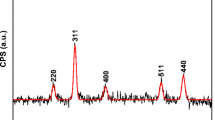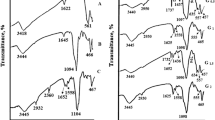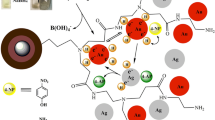Abstract
3-aminopropyltriethoxysilane was acrylated using the Michael addition reaction. After that, magnetite nanoparticles were coupled with the silane dispersion. The structure of poly(amino-ester) dendrons grafted on the surface of magnetite nanoparticles was characterized by FTIR spectroscopy and thermogravimetric analysis. Generally, in the convergent method structural control is better than in the divergent one due to its relatively low number of reactions at each growth step. Therefore, the number of dendrons grafted onto the surface of magnetite nanoparticles increase via convergent synthesis. Moreover, the analysis showed that the prepared nanoparticles had nanometric size, low polydispersity and high yield.

A Convergent Approach for the Preparation of the First Generation of Polyamino-Ester Dendrimer-Grafted Magnetite Nanoparticles from 3-Aminopropyltriethoxysilane (APTES)
Similar content being viewed by others
References
Khodadust R, Unsoy G, Yalcın S, Gunduz G, Gunduz U (2013) PAMAM dendrimer-coated iron oxide nanoparticles: synthesis and characterization of different generations. J Nanopart Res 15(3):1–13
Grayson SM, Frechet JM (2001) Convergent dendrons and dendrimers: from synthesis to applications. Chem Rev 101(12):3819–3868
Astruc D, Chardac F (2001) Dendritic catalysts and dendrimers in catalysis. Chem Rev 101(9):2991–3024
Adronov A, Fréchet JM (2000) Light-harvesting dendrimers. Chem Commun 18:1701–1710
Hecht S, Fréchet JM (2001) Dendritic encapsulation of function: applying nature’s site isolation principle from biomimetics to materials science. Angew Chem Int Ed 40(1):74–91
Florence AT, Hussain N (2001) Transcytosis of nanoparticle and dendrimer delivery systems: evolving vistas. Adv Drug Deliv Rev 50:S69–S89
Dufès C, Uchegbu IF, Schätzlein AG (2005) Dendrimers in gene delivery. Adv Drug Deliv Rev 57 (15):2177–2202
Gillies ER, Frechet JM (2005) Dendrimers and dendritic polymers in drug delivery. Drug Discov Today 10 (1):35–43
Wilhelm C, Gazeau F (2009) Magnetic nanoparticles: internal probes and heaters within living cells. J Magn Magn Mater 321(7):671–674
Wilhelm C, Gazeau F (2008) Universal cell labelling with anionic magnetic nanoparticles. Biomaterials 29 (22):3161–3174
Thorek DL, Tsourkas A (2008) Size, charge and concentration dependent uptake of iron oxide particles by non-phagocytic cells. Biomaterials 29(26):3583–3590
Bai X, Son SJ, Zhang S, Liu W, Jordan EK, Frank JA, Venkatesan T, Lee SB (2008) Synthesis of superparamagnetic nanotubes as MRI contrast agents and for cell labeling. Nanomedicine 3(2):163–174
Jang J, Lim H (2010) Characterization and analytical application of surface modified magnetic nanoparticles. Microchem J 94(2):148–158
Yallapu MM, Foy SP, Jain TK, Labhasetwar V (2010) PEG-Functionalized magnetic nanoparticles for drug delivery and magnetic resonance imaging applications. Pharm Res 27(11):2283–2295
Mahdavian AR, Mirrahimi MA-S (2010) Efficient separation of heavy metal cations by anchoring polyacrylic acid on superparamagnetic magnetite nanoparticles through surface modification. Chem Eng J 159(1):264–271
Kim J-E, Shin J-Y, Cho M-H (2012) Magnetic nanoparticles: an update of application for drug delivery and possible toxic effects. Arch Toxicol 86(5):685–700
Boyer C, Whittaker MR, Bulmus V, Liu J, Davis TP (2010) The design and utility of polymer-stabilized iron-oxide nanoparticles for nanomedicine applications. NPG Asia Mater 2(1):23– 30
Wang B, Wei Q, Qu S (2013) Synthesis and characterization of uniform and crystalline magnetite nanoparticles via oxidation-precipitation and modified co-precipitation methods. Int J Electrochem Sci 8:3786–3793
Wang H, Zhou Y, Guo Y, Liu W, Dong C, Wu Y, Li S, Shuang S (2012) β-cyclodextrin/ Fe3O4 hybrid magnetic nano-composite modified glassy carbon electrode for tryptophan sensing. Sens Actuators, B 163 (1):171–178
Zhou Y, Wang S, Xie K, Dai Y, Ma W (2011) Versatile functionalization of Fe3O4 nanoparticles via RAFT polymerization and click chemistry. Appl Surf Sci 257(24):10384–10389
Borlido L, Azevedo A, Roque A, Aires-Barros M (2013) Magnetic separations in biotechnology. Biotechnol Adv 31(8):1374– 1385
Kassaee M, Masrouri H, Movahedi F (2011) Sulfamic acid-functionalized magnetic Fe3O4 nanoparticles as an efficient and reusable catalyst for one-pot synthesis of α-amino nitriles in water. Appl Catal A 395(1):28–33
Sedlák M, Bhosale DS, Beneš L, Palarčík J, Kalendová A, Královec K, Imramovský A (2013) Synthesis and characterization of a pH-sensitive conjugate of isoniazid with Fe3O4 @SiO2 magnetic nanoparticles. Bioorg Med Chem Lett 23(16):4692– 4695
Wang L, Sun Y, Wang J, Wang J, Yu A, Zhang H, Song D (2011) Preparation of surface plasmon resonance biosensor based on magnetic core/shell Fe3O4/SiO2 and Fe3O4/Ag/SiO2 nanoparticles. Colloids Surf B 84(2):484–490
Chomoucka J, Drbohlavova J, Huska D, Adam V, Kizek R, Hubalek J (2010) Magnetic nanoparticles and targeted drug delivering. Pharmacol Res 62(2):144–149
Veiseh O, Gunn JW, Zhang M (2010) Design and fabrication of magnetic nanoparticles for targeted drug delivery and imaging. Adv Drug Deliv Rev 62(3):284–304
Du X, He J, Zhu J, Sun L, An S (2012) Ag-deposited silica-coated Fe3O4 magnetic nanoparticles catalyzed reduction of p-nitrophenol. Appl Surf Sci 258(7):2717–2723
Pourjavadi A, Hosseini SH, Hosseini ST, Aghayeemeibody SA (2012) Magnetic nanoparticles coated by acidic functionalized poly (amidoamine) dendrimer: effective acidic organocatalyst. Catal Commun 28:86–89
Dayyani N, Khoee S, Ramazani A (2015) Design and synthesis of pH-sensitive polyamino-ester magneto-dendrimers: surface functional groups effect on viability of human prostate carcinoma cell lines DU145. Eur J Med Chem 98:190–202
Sadri F, Ramazani A, Massoudi A, Khoobi M, Tarasi R, Shafiee A, Azizkhani V, Dolatyari L, Joo SW (2014) Green oxidation of alcohols by using hydrogen peroxide in water in the presence of magnetic Fe3O4 nanoparticles as recoverable catalyst. Green Chem Lett Rev 7(3):257–264
Sadri F, Ramazani A, Massoudi A, Khoobi M, Azizkhani V, Tarasi R, Dolatyari L, Min B -K (2014) Magnetic CoFe2O4 nanoparticles as an efficient catalyst for the oxidation of alcohols to carbonyl compounds in the presence of oxone as an oxidant. Bull Korean Chem Soc 35(7):2029–2032
Sadri F, Ramazani A, Massoudi A, Khoobi M, Joo S (2015) Magnetic CuFe2O4 nanoparticles as an efficient catalyst for the oxidation of alcohols to carbonyl compounds in the presence of oxone as an oxidant. BulgChem Commun 47(2):539–546
Ramazani A, Sadri F, Massoudi A, Khoobi M, Joo SW, Dolatyari L, Dayyani N (2015) Magnetic ZnFe2O4 nanoparticles as an efficient catalyst for the oxidation of alcohols to carbonyl compounds in the presence of oxone as an oxidant. Iran J Catal 5(3):285–291
Pan B-F, Gao F, Gu H-C (2005) Dendrimer modified magnetite nanoparticles for protein immobilization. J Colloid Interface Sci 284(1):1–6
Author information
Authors and Affiliations
Corresponding author
Rights and permissions
About this article
Cite this article
Dayyani, N., Ramazani, A., Khoee, S. et al. Synthesis and Characterization of the First Generation of Polyamino-Ester Dendrimer-Grafted Magnetite Nanoparticles from 3-Aminopropyltriethoxysilane (APTES) via the Convergent Approach. Silicon 10, 595–601 (2018). https://doi.org/10.1007/s12633-016-9497-6
Received:
Accepted:
Published:
Issue Date:
DOI: https://doi.org/10.1007/s12633-016-9497-6




